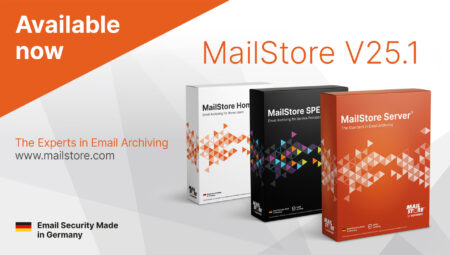
Tech Tips: The Right Archiving Strategy
In our Tech Tips blog series, we want to give all interested parties, customers, and partners detailed information on selected product features and demonstrate how these can be used in MailStore Server. As well as providing brief background information on the topic in question, each blog post in this series includes a video. In this video, our Technical Support Engineer will show you what you need to consider when choosing the right archiving strategy for your company.
Which Archiving Strategy Is Best Suited to My Company?
MailStore Server offers two different options for archiving emails. But before a company starts archiving, it should carefully consider what type of archiving is best suited to its needs. The choice of archiving strategy depends both on the email infrastructure – for example, whether an on-premises Exchange Server exists or Microsoft Office 365 is being used – and on individual objectives.
The following question is paramount: are emails to be archived in a manner that strives for compliance with regulatory purposes OR should the folder structure created by the employees in the email client be emulated in the archive, with simultaneous relief of the load on the email server? These two methods, known as journal and mailbox archiving respectively, are explained below.
Journal Archiving: The Prerequisite for Legal Safeguard
This method involves archiving all emails before they are delivered to the users. This is achieved by creating a journal rule in the Microsoft Exchange Server or an Office 365 environment which ensures that all incoming and outgoing emails are automatically copied to an individually definable mailbox. In most cases, a rule can be used to achieve the same result even if another server is being used. A comprehensive list of product-specific instructions is available in the “Implementation Guides” section of our MailStore Help.
The appropriate archiving profile can now be created and MailStore will archive all emails before users can delete or tamper with them. As far as the company or organization is concerned, the integrity of the archive is guaranteed, helping them to meet a growing number of regulations on email compliance, eDiscovery and other legislation.
Mailbox Archiving: Folder Structure in the Archive and Reducing the Load of the Email Server
This method archives all the emails from the users’ respective mailboxes. This can be achieved either by accessing the email server directly or, for want of another option, by archiving the email clients. The advantage of this method is that the given folder structure and the complete history of all the emails in the user’s mailbox are transferred to the archive. In addition, delete rules can be created to ensure that, for example, all emails that are older than two years are automatically deleted from the mailbox once they have been successfully archived. This approach helps to permanently reduce the load of the email server. Users are still able to search for and access their emails in the familiar folder structure via the archive.
Our Recommendations for Archiving Emails
Ultimately, a company will choose the archiving approach that best suits its individual needs. Because it helps companies to meet a growing number of regulations, MailStore advocates journal archiving, while also offering the following additional recommendations:
- The archiving profiles can and – of course – should be automated. In the case of journal archiving (i.e. where incoming and outgoing emails are archived directly), the default value of 300 seconds between archiving operations should be configured.
- In the case of mailbox archiving, we advise that you run the archiving operation once a day, either in the evening or at night, when the load on the email server is at its lowest.
- If you opt for journal archiving, we recommend that you perform a mailbox archive run at least once beforehand in order to ensure that existing emails are archived and remain permanently available. Emails that have been stored on a decentralized basis (e.g. in PST files) can also be archived during this step.





